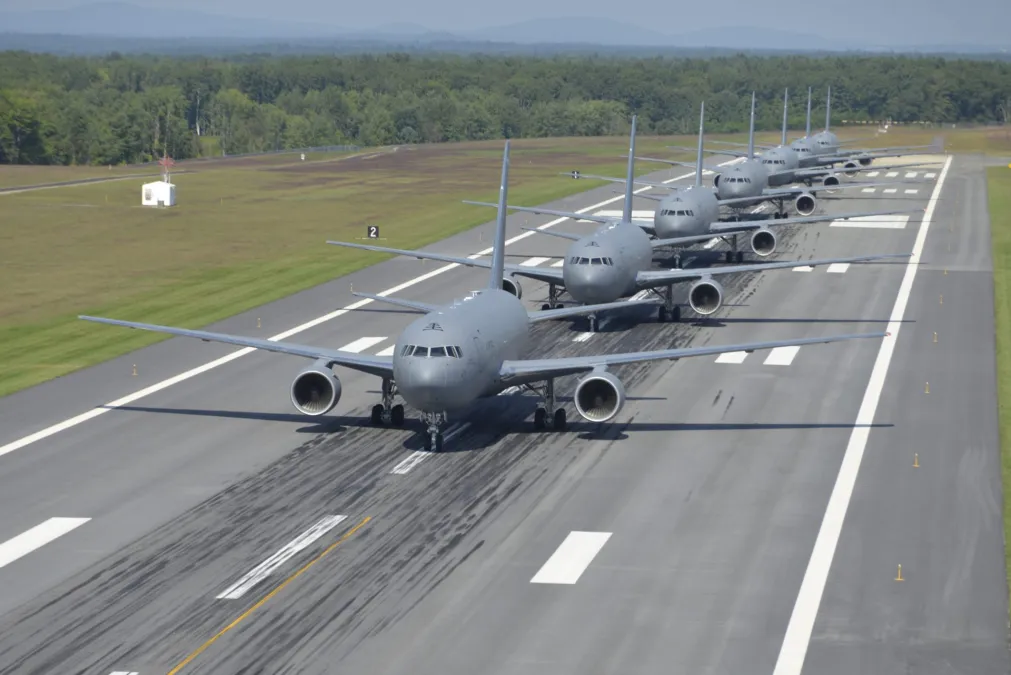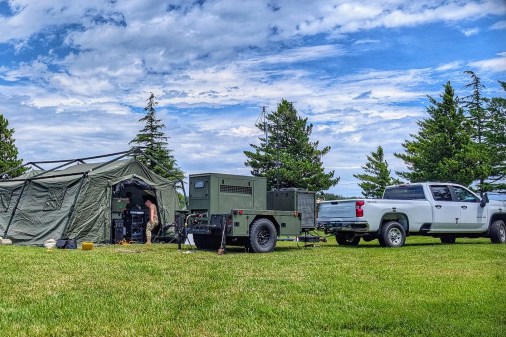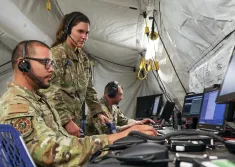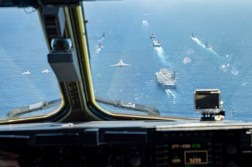With operational plan in place, Air Force moves to connect aircraft to DAF Battle Network

DAYTON, Ohio — The Department of the Air Force’s integrating program executive office for command, control, communications and battle management (C3BM) has begun work to tie some of the service’s aircraft into its distributed network of systems and capabilities.
Since becoming the Air Force’s first PEO for C3BM in 2022, Brig. Gen. Luke Cropsey and his team have focused on developing a plan and associated baseline architecture that will connect the Air and Space Forces’ sensors and shooters under a single network known as the DAF Battle Network. After nearly two years of work, Cropsey said his office is now having discussions with other Air Force PEOs to understand how the service can connect its air platforms into that network based on their respective roles in operations.
“What you’re starting to see are conversations at the DAF Battle Network level that are targeting specific platforms because of the role that they play in those mission threads with specific requirements and capabilities,” Cropsey told DefenseScoop this week during a media roundtable at the Air Force Life Cycle Industry Days. “How am I going to connect to you? What is that going to look like? Where are you going to exist in that scheme of maneuver? How connected do you need to be?”
The effort is associated with the Pentagon-wide initiative known as Combined Joint All-Domain Command and Control (CJADC2), which aims to enable rapid data transport across a distributed network of sensors and weapons from every military domain. The goal is to give military leaders the ability to quickly ingest information about incoming threats, as well as a clear set of options to defeat them.
“It’s the system of systems that C3BM as a PEO is designing and fielding,” Cropsey said. “That system of systems is designed to connect all the other parts and pieces that are inside of that battlespace together, so that we can fight as a unified whole.”
Having an operational plan in place creates a clear path to fielding what will become the DAF Battle Network — including which platforms will have to be integrated, as well as how that connection will happen and how often, Cropsey said. PEO C3BM is talking with leaders across both the Air and Space Forces to do so, he said.
Effort is now focused on assigning communications tasks to each platform based on what missions they perform and addressing the complex engineering challenges involved with connecting them under one network. Cropsey noted that priority is being decided based on conversations he’s having with the operational community about their roles in executing the kill chain — a difficult task considering most platforms perform more than one mission.
“Who’s doing what part of those things turns into a really complicated engineering problem really fast, because in a lot of cases you’re probably doing a couple of them and you may be doing them temporarily in different places at different times,” Cropsey said.
Understanding a platform’s operational function is also shedding light on the equipment and capabilities that will need upgrades in order to connect to the DAF Battle Network. In some cases, an aircraft’s communications suite will allow it to be integrated as is. But in others, systems will need to be upgraded with new software or replaced entirely, he said.
“Once we understand what role that platform is playing in that operational plan, then we can figure out how good it has to be in terms of its connectivity and its data in order to do that role. And that’s actually putting a lot of clarity around what the engineering choices are left and right,” Cropsey said.
However, the Air Force’s budget is also influencing how quickly PEO C3BM can move. Cropsey has previously described how the department’s current budget and bureaucratic processes are inhibiting his team in deploying and scaling new C2 capabilities such as the Cloud Based Command and Control (CBC2) platform and the Tactical Operations Centers-Light (TOC-L) battle management kit.
Budget restrictions have impeded the ability of some the Air Force’s platforms to receive upgraded communications technology. Gen. Mike Minihan, head of Air Mobility Command, told lawmakers in July that his goal of equipping a quarter of the mobility fleet with new situational awareness capabilities — an effort called “25 by ’25” — would not be met before the end of his tenure in September.
Speaking to the House Armed Services Committee, Minihan said that “decades of underinvestment in mobility” during peacetime was one reason AMC would not reach the goal.
Cropsey agreed, but added that while “25 by ’25” wouldn’t pan out the way the service intended, his office was still working with AMC and other Air Force major commands to find workarounds to the system.
“There’s a bureaucratic process in place, and that creates its own set of drag in the system,” Cropsey told reporters. “Are there things that we can be doing smarter about how we’re trying to get capability? Or are there other options that are cheaper and faster that maybe your team hasn’t thought of that the nerd herd rolls in with and helps out?”
During another media roundtable at the conference, Kevin Stamey, PEO for mobility and training aircraft, emphasized that his office is closely working with Cropsey’s to ensure the mobility fleet is modernized with new communications systems. Its two priority platforms right now are the KC-46 Pegasus tanker and the C-17 Globemaster transport aircraft, he said.
“It’s not something you can just slap on. It’s got to be incorporated. But we have plans across the entire mobility fleet to start putting information in the cockpits,” Stamey said. “It’s important that we’re not rushing to failure. We want to make sure that what we’re putting in the cockpit is going to work with the future DAF Battle Network.”
The PEO for mobility and training aircraft has a number of efforts underway to improve connectivity on its platforms, as Stamey noted that the mobility fleet has significantly less situational awareness than others in the Air Force. Those include the Multi-Orbit Hardware Adaptable Wideband Kit (MOHAWK) and incorporating hybrid satellite communications systems onto aircraft to enable beyond-line-of-sight communication.
The Air Force will also fly a communications prototype — known as capability release 1 — onboard a KC-46 during the Emerald Flag multi-service exercise in October, Cropsey said. He noted that the effort is still on schedule, despite needing to scale it down.
The service’s program executive office for bombers is also eyeing how it will modernize connectivity into its fleet to be a part of the DAF Battle Network, including upgrades to the legacy B-1 Lancer and B-2 Spirit. As the service shifts towards a two-bomber fleet — comprising modernized B-52 Stratofortress aircraft and the upcoming B-21 Raider — the Air Force is currently defining how they will serve as a long-range strike capability in future conflicts, said Brig. Gen. Erik Quigley.
“It’s all about connectivity and communication and making sure we can close what we call the long-range kill chain. We can do that with some fighters, but also bombers have a critical role with that — especially in a contested environment,” Quigley, PEO for bombers, told reporters during another roundtable.
The service’s program executive office responsible for ISR systems is also taking a hard look at how it will modernize to connect sensors to the DAF Battle Network. A critical task will be paying close attention to Cropsey’s overarching network architecture and plan, as that will be key to creating a system-of-systems sensing capability, said Col. Joshua Williams, PEO for intelligence, surveillance, reconnaissance and special operations forces.
“A lot of our systems are platform-focused and platform-built. Now we’re learning how we take this platform and the architectures that were built specifically for a platform, and how do we apply that on a common architecture?” Williams said at a media roundtable. “So how do we take these capabilities through open systems and open interfaces, to then integrate — whether it be an ISR asset sensing [or] an E-7 Wedgetail in the future — to watch the eyes on the battlefield to produce information to decision makers and potentially operators?”






